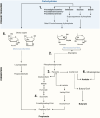A metaproteomic analysis of the piglet fecal microbiome across the weaning transition
- PMID: 40384785
- PMCID: PMC12082470
- DOI: 10.3389/fmicb.2025.1504433
A metaproteomic analysis of the piglet fecal microbiome across the weaning transition
Abstract
Microbiome analysis has relied largely on metagenomics to characterize microbial populations and predict their functions. Here, we used a metaproteomic analysis of the fecal microbiome in piglets before and after weaning to compare protein abundances as they pertain to microbial populations specific to either a milk- or plant-based diet. Fecal samples were collected from six piglets on the day of weaning and 4 weeks after transitioning to a standard nursery diet. Using the 12,554 protein groups identified in samples, we confirmed the shift in protein composition that takes place in response to the microbial succession following weaning and demonstrated the redundancy in metabolic processes between taxa. We identified taxa with roles as primary degraders based on corresponding proteins synthesized, thereby providing evidence for cross-feeding. Proteins associated with the breakdown of milk-specific carbohydrates were common among pre-weaned pigs, whereas the proteome of post-weaned piglets contained a greater abundance of proteins involved in the breaking down plant-specific carbohydrates. Furthermore, output revealed that production of propionate takes place via the propionaldehyde pathway in pre-weaned piglets, but changes to production via the succinate pathway in post-weaned piglets. Finally, a disproportionate quantity of carbohydrate-active enzymes (CAZymes) (~8%) were produced by fungi, which typically only represent ~0.1% of the microbiome taxa. Information gathered through this characterization of the metaproteome before and after weaning revealed important differences regarding the role of members in the microbial community, thereby providing information for the optimization of diets and products for both piglet and microbiome health.
Keywords: digestion; metaproteome; microbiome; swine; weaning.
Copyright © 2025 Rivera, Harlow, Cole, O’Meally, Garrett, Xiong, Oliver, Wells, Summers, Chhetri, Postnikova, Rempel, Crouse, Neville and Davies.
Conflict of interest statement
The authors declare that the research was conducted in the absence of any commercial or financial relationships that could be construed as a potential conflict of interest.
Figures







Similar articles
-
Weaning Age and Its Effect on the Development of the Swine Gut Microbiome and Resistome.mSystems. 2021 Dec 21;6(6):e0068221. doi: 10.1128/mSystems.00682-21. Epub 2021 Nov 23. mSystems. 2021. PMID: 34812652 Free PMC article.
-
Lactation-related dynamics of bacterial and fungal microbiomes in feces of sows and gut colonization in suckling and newly weaned piglets.J Anim Sci. 2024 Jan 3;102:skae321. doi: 10.1093/jas/skae321. J Anim Sci. 2024. PMID: 39460650 Free PMC article.
-
The dynamics of the piglet gut microbiome during the weaning transition in association with health and nutrition.J Anim Sci Biotechnol. 2018 Jul 30;9:54. doi: 10.1186/s40104-018-0269-6. eCollection 2018. J Anim Sci Biotechnol. 2018. PMID: 30069307 Free PMC article.
-
Exposure to plant-oriented microbiome altered jejunal and colonic innate immune response and barrier function more strongly in suckling than in weaned piglets.J Anim Sci. 2022 Nov 1;100(11):skac310. doi: 10.1093/jas/skac310. J Anim Sci. 2022. PMID: 36165740 Free PMC article.
-
Plant-oriented microbiome inoculum modulates age-related maturation of gut-mucosal expression of innate immune and barrier function genes in suckling and weaned piglets.J Anim Sci. 2023 Jan 3;101:skad165. doi: 10.1093/jas/skad165. J Anim Sci. 2023. PMID: 37217284 Free PMC article.
References
LinkOut - more resources
Full Text Sources

